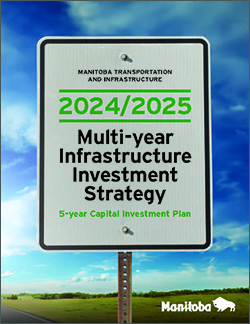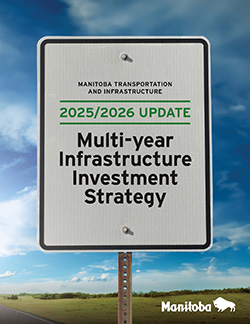MTI Infrastructure Plans
2024/2025 Multi-Year Infrastructure Investment Strategy
Manitoba Transportation and Infrastructure (MTI) has created this investment strategy to improve transparency and provide the public, relevant stakeholders and rights holders with information on both future and ongoing projects. The updated 2024/2025 Multi-year Infrastructure Investment Strategy outlines a five-year plan that details the department’s goals to invest in new and existing highway, water, airport and general assets. It is intended to provide a more comprehensive picture of the department’s capital plan and enhance collaboration with MTI’s stakeholders, which is crucial to the department’s work improving and maintaining public infrastructure across the province.
Projects listed within this document are organized to reflect the four strategic investment categories: infrastructure renewal, economic development, climate resiliency, and connectivity and innovation. These investments will strengthen and complement projects under key MTI initiatives such as the Trade and Commerce Grid Initiative, Winnipeg Perimeter Freeway Initiative, and Enhancing National Trade Corridors Strategy. The 2024/2025 Multi-year Infrastructure Investment Strategy also introduces new initiatives such as the Improve Road Safety Strategy. It also describes critical projects within the department`s portfolio including the Lake Manitoba and Lake St. Martin Outlet Channels, the twinning of the Trans-Canada Highway to the Ontario border and the new airport at Wasagamack First Nation.
A new 2025/2026 Multi-year Infrastructure Investment Strategy companion package has been created for fiscal years 2025/2026 through to 2029/2030.
The companion document provides updated project tables of MTI’s planned and ongoing capital projects.
The mapped location and status of projects that are currently included in the 2025/2026 Multi-year Infrastructure Investment Strategy are located here: Manitoba Infrastructure Projects Map.
- 2024/2025 Multi-year Infrastructure Investment Strategy (PDF)
- 2025/2026 Multi-year Infrastructure Investment Strategy companion package (PDF)




